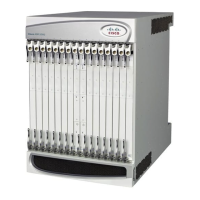Network Address Translation Overview
Cisco ASR 5000 Series Product Overview ▄
NAT IP Address Deallocation
Whenever a NAT IP address is deallocated, all the port-chunks associated with the subscriber are released back to the
pool.
In case there is only one port-chunk associated with the subscriber:
In case of many-to-one not-on-demand NAT IP pools, the last port-chunk is not released back to the pool even
after NAT Binding Timer expires. Only when the call gets disconnected, the port-chunk is released along with
the NAT IP address.
In case of many-to-one on-demand NAT IP pools, when the last flow using the port-chunk gets cleared, the NAT
Binding Timer is started. When the NAT Binding Timer expires, the port-chunk along with the NAT IP
address is released back to the pool.
In case of one-to-one on-demand NAT IP pools, when there are no active flows using a NAT IP address, the
NAT Binding Timer is started. When the NAT Binding Timer expires, the NAT IP address gets deallocated.
NAT Port-chunk Allocation and Deallocation
This section describes the Port-chunk Allocation and Deallocation feature for many-to-one NAT.
NAT Port-chunk Allocation
Subscribers sharing a NAT IP address are allocated NAT ports in chunks. The ports in a port-chunk are always used for
the subscriber to whom that port-chunk is allocated irrespective of the protocol.
Whenever a NAT IP address gets allocated to a subscriber, the first port-chunk gets allocated along with the NAT IP
address. Thus, for not-on-demand pools, the first port-chunk gets allocated during call setup, and for on-demand pools
during data flow.
A subscriber‘s TCP and UDP data traffic is NATed with ports chosen in a random fashion from the port-chunk allocated
to that subscriber. For other protocol traffic, the first available port is allocated. When all the ports in a port-chunk are in
use, a free port-chunk is requested for. A new port-chunk is only allocated if the ―Maximum Port-chunks Per User‖ limit
is not reached.
NAT Port-chunk Deallocation
A port-chunk gets deallocated in the following cases:
―NAT Binding Timer‖ expiry
Subscriber session disconnect

